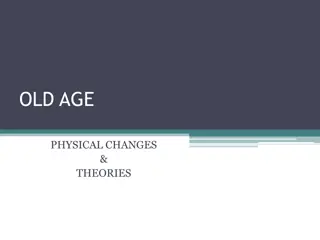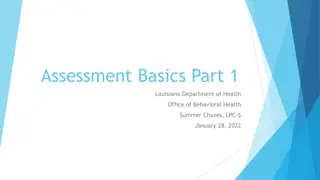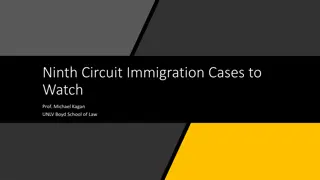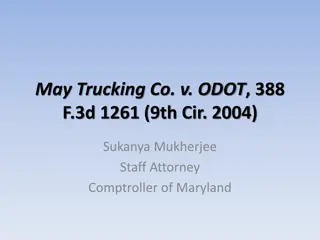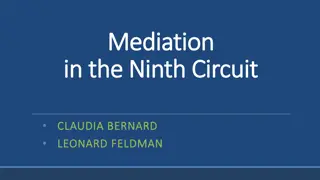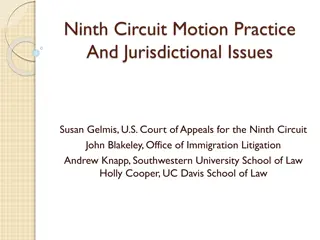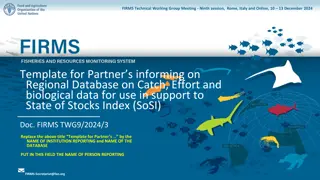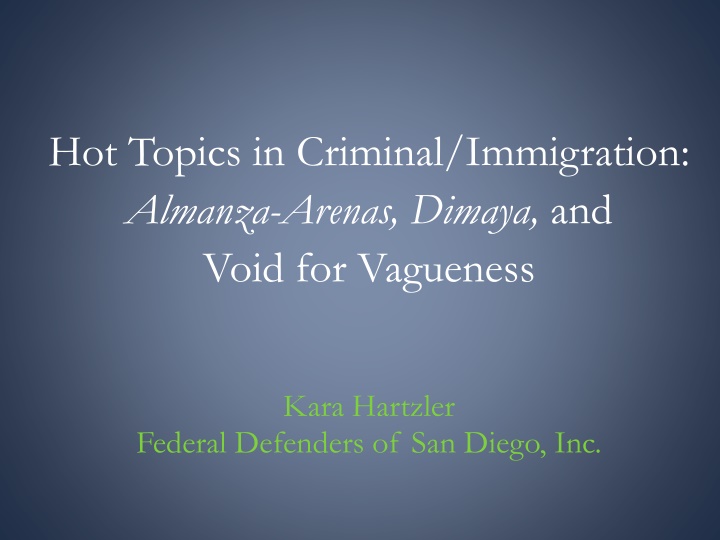
Criminal Immigration Law Topics: Almanza-Arenas, Dimaya, and Void for Vagueness
Explore key legal decisions such as Almanza-Arenas and Descamps that impact criminal immigration law, including divisible statutes, jury requirements, and court interpretations. Understand the nuances of disjunctive terms and elements in statutes for effective legal analysis.
Download Presentation

Please find below an Image/Link to download the presentation.
The content on the website is provided AS IS for your information and personal use only. It may not be sold, licensed, or shared on other websites without obtaining consent from the author. If you encounter any issues during the download, it is possible that the publisher has removed the file from their server.
You are allowed to download the files provided on this website for personal or commercial use, subject to the condition that they are used lawfully. All files are the property of their respective owners.
The content on the website is provided AS IS for your information and personal use only. It may not be sold, licensed, or shared on other websites without obtaining consent from the author.
E N D
Presentation Transcript
Hot Topics in Criminal/Immigration: Almanza-Arenas, Dimaya, and Void for Vagueness Kara Hartzler Federal Defenders of San Diego, Inc.
Almanza-Arenas En banc decision issued Dec. 28, 2015 In applying the Taylor categorical approach, when is a disjunctive statute divisible such that courts may proceed to the modified categorical approach?
Background - Descamps A divisible statute contains multiple, alternative elements Elements are what a jury must unanimously agree on Courts can only look to the ROC to determine the elements of a conviction not the means by which it was committed
Background - Descamps Fn. 2: And if the dissent's real point is that distinguishing between alternative elements and alternative means is difficult, we can see no real-world reason to worry. Whatever a statute lists (whether elements or means), the documents we approved in Taylor and Shepard i.e., indictment, jury instructions, plea colloquy, and plea agreement would reflect the crime's elements. So a court need not parse state law in the way the dissent suggests: When a state law is drafted in the alternative, the court merely resorts to the approved documents and compares the elements revealed there to those of the generic offense.
Background Chairez/Rendon Descamps involved a single, indivisible term ( entry ) How does Descamps apply to statutes with disjunctive terms? ( x, y, or z ) Matter of Chairez, 26 I&N Dec. 349 (BIA 2014): Must look to state law to determine if jury unanimity required If in 237, burden on DHS
Background Chairez/Rendon Rendon v. Holder, 764 F.3d 1077 (9th Cir. 2014): can only use ROC when state law requires jury to decide between alternatives Must look to state case law and jury instructions
Background Dissent to Rendon rhring Nine judges dissent from denial of rehearing in Rendon J. Graber: Descamps fn. 2 means that disjunctive = divisible, doesn t turn on means/elements J. Kozinski: turns on means/elements but you should peek at Shepard documents to determine elements
Almanza-Arenas Non-LPR with Unlawful Taking of Vehicle applied for 42b Cancellation 10851 = temporary or permanent Matter of Almanza-Arenas, 24 I&N Dec. 771 (BIA 2009): statute is divisible and applicant for relief has burden to show temporary taking Inconclusive record is not enough
Almanza-Arenas: 9th Panel Decision Two holdings: 1. 10851 not divisible under Rendon 2. Even if it were, Moncrieffe overruled rule in Young and held that an inconclusive record establishes eligibility for relief
Almanza-Arenas: En Banc Decision En banc panel included 5 judges who had signed on to Judge Graber s dissent Upheld means/elements in 10-1 decision Concur. (4 judges): Congress should ditch categorical approach Concur. (J. Watford): Would have found divisible but that inconclusive record established eligibility for relief
Steps for Determining Divisibility First step: look at text of statute: Any person who drives or takes a vehicle not his or her own, without the consent of the owner thereof, and with intent either to permanently or temporarily deprive the owner thereof of his or her title to or possession of the vehicle
Steps for Determining Divisibility Second step: Confirm elements by examining Shepard docs per Descamps fn 2 Here, prosecutor charged intent either permanently or temporarily to deprive Because prosecutors can t charge two offenses in same count, must be means, not elements But prosecutors don t always charge correctly, so may have to look beyond Shepard documents
Steps for Determining Divisibility Third step: Verify elements by looking to state case law and jury instructions In Rendon, where statute didn t provide a clear answer, court looked to state law. Because jury instructions resolved that temp/permanent distinction is a means, majority found it need not look to state case law
Footnote 2 Majority reads fn 2 as a guide to look to Shepard documents if there is difficulty in distinguishing between the elements and means Recognized circuit split with 10th and 5th Circuits
Determining Divisibility 1. Statute s text (new) 2. Shepard docs (new) 3. State law (Rendon/Chairez) Will judges incorrectly stop after finding statute divisible under step 1 or 2? Will they skip to step 3? How can we use steps 1 and 2?
Other Questions Who has the burden to prove jury unanimity is required? Should it turn on whether the person is deportable/inadmissible? What s the law on second issue of eligibility for relief?
Looking Ahead SG agrees cert should be granted on divisibility: Mathis v. U.S., Case No. 15- 6092 Upcoming cases on 2nd issue of eligibility for relief AG currently reconsidering Matter of Chairez
Dimaya v. Lynch Applied Supreme Court Johnson decision (finding ACCA residual clause void for vagueness) to 18 U.S.C. 16(b) Ag fel COV must have an element of force not just risk of force OIL petition for rehearing pending
What CA Crimes Fall Under 16(b)? Residential burglary 459 Robbery 211 (but watch for theft) Kidnapping 207 False Imprisonment (various) Lewd & Lascivious with 14-15 288(c) Sexual Battery 243.4
What Else Is Void for Vagueness? Matter of Valenzuela-Gallardo (obstruction of justice) CIMTs? Modified categorical approach?


